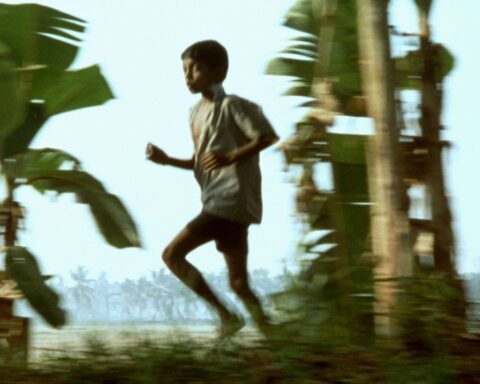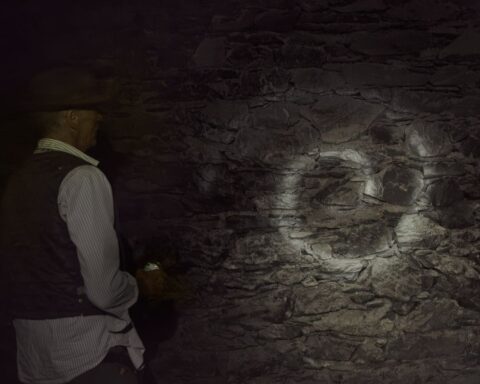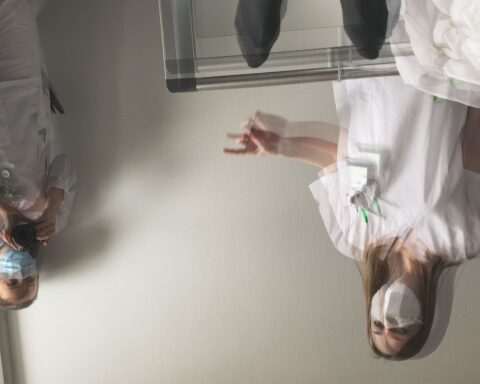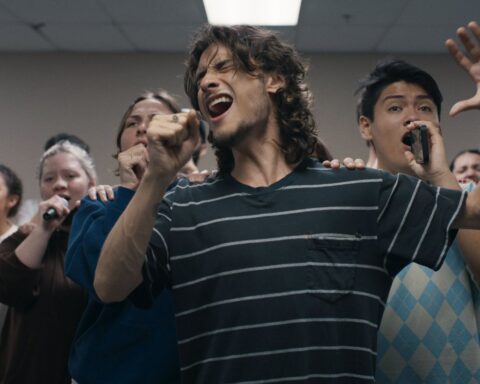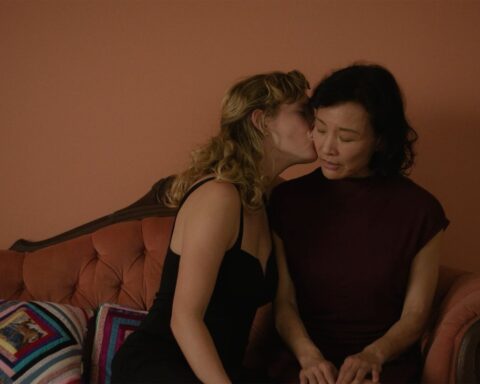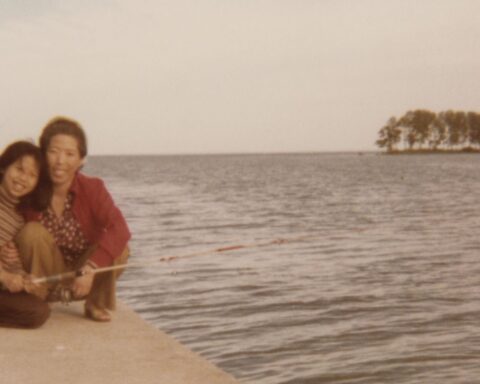Peter Mettler makes films that defy genres. His latest, Petropolis, which will have its North American premiere at the Toronto International Film Festival, documents the Alberta Tar Sands, an environment turned into a wasteland in order to produce oil. Instead of offering a standard doc on the subject, Mettler has created an astonishingly beautiful art film that makes its point through aesthetics, not didactic politics. The viewer is given an aerial view of a land dominated by industrial machinery, toxic lakes and a grey, muddy, hazardous terrain. His roving camera reveals what is beyond the sands—trees, greenery and blue sky.
The methodology of Petropolis is pure Mettler: he shows images and assumes the viewer can make connections. Gambling, Gods and LSD (2002), his previous film and magnum opus to date, attempted the impossible. He proposed to document the ineffable—chance, ecstasy and the divine. Audiences worldwide were captivated by his risky approach and the wildly divergent stories he captured in a unique cinematic essay.
Since the release of Gambling, Gods, Mettler has been involved in meta-cinema projects, creating visuals to dance pieces and music. He has turned film into an instrument that can be played “live” with guitarists, dancers and DJs.
Working with director Jennifer Baichwal and producer Nick de Pencier in 2005 and 2006, he shot Manufactured Landscapes, an innovative look at his old compatriot from Ryerson College days, photographer Ed Burtynsky.
And he’s been working on a new film called End of Time.
In part one of a career-spanning interview, Mettler—who has worked with Atom Egoyan, Fred Frith, Robert Lepage and so many others—shares his thoughts about his work since Gambling, Gods with Point of View editor Marc Glassman. (Click here to read part two of the interview)
POV: Marc Glassman
PM: Peter Mettler
POV: Your new film, Petropolis, is remarkable. It’s beautifully shot, with amazing aerial footage of the Alberta Tar Sands. What brought you out there to make the film, which has already won the “Prix du jury du jeune public” at this year’s Visions du Réel Festival?
PM: I’ve been working on a new film, which has the working title End of Time. One of the elements of that film is looking at the atmosphere. What’s contained in the clouds around the globe? I was struck by images I’d seen of the tar sands and their emissions. That was my attractor. After doing some initial research, I wanted to go out there.
Coincidentally someone from Green-peace called me and asked if I could recommend a cameraperson to work with them on a project they were doing on the tar sands. So I said ‘I’ll do it, but in exchange for my services I can use any footage we collect for my own film.’ We made that agreement. I went out there once with them. We were working on the ground, like a documentary unit, exploring things. It was difficult to get any kind of access, even on roadsides, to see what was going on. Security would come instantly, even though we were on public property.
One of the solutions was obviously to go up into the air. Not only for access but because it’s only from the air that you understand the scope of the [oil extraction] operation and you start to understand the relationships of the forest to the mining, just how massive it all really is.
We did a preliminary flight on our first visit using a regular video camera, with me hanging out of the helicopter, looking at what was there, getting the lay of the land. In the weeks that followed, we mapped out a route, like a story board, of the kinds of things and transitions you could get from the air to show this place. Rental of the stabilized HD camera system and helicopter time is very expensive so preparation was important.
Once we eventually did the shooting we were only in the air for three hours. When I saw the footage afterwards, I thought it could be a really nice film just in its own right, as an impression of this place, not including all the interviews we did on the ground and all the informational footage, but just as an emotional, visual impression of what was going on there. I proposed to Greenpeace, ‘If you would like me to make a film out of this material in the way that I work, I’d be happy to do it.’ They said yes pretty well immediately. I was unsure if they understood what I meant, so I kept referring to my other work, like Picture of Light, and saying, ‘what I see is actually quite visceral and lyrical and musical. Are you sure you want this? Will this work for you?’ Their own media work tends to be information-based, functioning like propaganda. They said ‘yes, yes, yes.’ So we proceeded, and the film came out of it.
POV: Who did you work with most closely at Greenpeace?
PM: Spencer Tripp. He’s the head of communications in Canada and the Executive Producer of the film. He’s really interested in creating a different kind of collaboration with filmmakers. I see it the same way. A lot of us as filmmakers are working with these [sustainability] issues. What’s wrong, for example, with combining the forces of Greenpeace, the NFB and Arte? They’re all funding institutions or producing institutions offering different kinds of connections and audiences. It was an interesting experiment, for both of us, venturing into unfamiliar collaborative territory both in form and production.
POV: Were you concerned about being compromised by having your film produced for Greenpeace?
PM: At the beginning, that was my reservation. I wanted to feel that I could make the film in the way that I would as an auteur, while bearing in mind that I was making it with Greenpeace. I wanted to make something that would be usable by them because our interests are ultimately the same. I was really moved by what I saw, by the implications of what’s going on. Here was an easy opportunity to do something [for a worthwhile cause]. There was no money. I did everything for free, the entire film, but with that they honoured that I could make the kind of film I could stand by. It wasn’t a commission, it was a partnership around a mutual desire to show this [situation in Alberta] to Canadians and to the world. It’s simple that way. It presents a visual of what that place is.
POV: You’ve made a beautiful art film with documentary elements. Did you ever seriously consider having interview footage? Or more voiceovers?
PM: There was almost no budget or time to make Petropolis. We didn’t shoot the film exhaustively the way you might with a normal documentary, but we did shoot a considerable amount of interview and other material along the way. In editing, Roland Schlimme and I went through this material and loosely tried what it would be like to intercut it with the aerials. Additionally I wrote and recorded, as I often do, an extensively verbose voiceover that had everything I thought to be important in it and put it over the film to get an initial impression of how that would resonate. The thing that seemed to work the best and seemed the most profound, was a minimum of voiceover, just a few lines, and a few facts that make you understand the basics of what you’re seeing.
Greenpeace did, however, put a lot of that unused interview material online for reference. Andrew Nikiforuk has also written an amazing and thorough book about the tar sands implications.
POV: You shot Manufactured Landscapes for Jennifer Baichwal about the photographer Ed Burtynsky and his remarkable work, which looks tremendously beautiful at first glance and then is revealed to be depicting dreadful conditions for workers and the environment. Did you think of Burtynsky while making Petropolis?
PM: Absolutely. It’s funny with Ed. We went to Ryerson [in Toronto] at the same time and we’ve related to each other over the years on our separate paths. Our interests and themes have crossed over at various points since then, although our approaches are very different. But during the shooting of Manufactured Landscapes, they fused together.
POV: Burtynsky is a photographer and you’ve shot stills as well as being a cinematographer. Do you find the forms to be similar?
PM: Not so much. Film is very different from photography. You’re moving through a timeline and dealing with motion when you’re shooting a film—not to mention the presence of sound. With Manufactured Landscapes, film offered the potential to go in to study things, to talk to people. There are many layers to the paradoxically beautiful and obscene images that Ed presents to us. In the case of Petropolis, I’d actually talked to Ed because he’d already shot the tar sands. It’s a hard thing to photograph due to its immensity. The timeline of even a single moving shot reveals different relationships and dimensions of a space.
POV: Did it worry you that dealing with the technical challenges might overwhelm the production?
PM: But, you see, one of the things that I tried to do with Petropolis, that came from the material, was to deal with this absurd situation of being up in a helicopter, this high tech machine, with extremely technical camera gear hanging on the nose of it, controlled by remote dials and knobs inside the helicopter, three of us, the pilot, the operator and me, all connected together, talking as one, trying to guide the camera. We were in this machine with a highly evolved technology, looking down on all these other machines, these massive trucks the size of houses, bulldozers, all the things they’re doing to move the earth around— and I realized that we’re one and the same. We’re the consciousness of the machinery looking at itself. I wanted to amplify that concept somewhat. Therefore, in the final edited selection you see a lot of camera readjustment. You feel the robotics of the eye, the mechanization of the camera, the feeling of the helicopter. The absurdity is enhanced by the fact that the helicopter is fuelled by the resource they’re taking out of the ground, oil. It’s like this little infant is looking down at its mother, the source of its nourishment. That relationship was really striking to me.
Going back to Ed’s photos, it’s something that’s not so overtly in the picture —the photographer’s presence, the presence of his shooting. The gesture of the film camera is immediately more pronounced than that of the shutter release on a still camera.
POV: The music conveys a sense of space while also having an industrial feel to it. How did you choose the composer?
PM: It was another pleasant coincidence. I love it when films happen this way. Petropolis came about through the process of research for another film, and simultaneously Gabriel Scotti, a musician in Geneva, sent me an email. He’d seen Gambling, Gods and LSD and was very excited about it. He said, ‘I related strongly to your film and I think you’ll really like my music.’ He sent me some music and he was right. The timing was perfect, so I said, ‘How about sending me a lot of your music (if you want) and we’ll work with it as the bed for this film?’ Also for him, it was a contribution to the cause. He said, ‘How could I not do that for the birds?’ A sweet line.
I pulled the parts I liked; as with other musicians, he was open to my remixing it and layering it, taking pieces of different compositions and making new compositions out of the elements he supplied. It came into the flow at the right time.
POV: Did he compose all the music?
PM: He did but composition for him also includes pieces by other composers that he stretches 2000%. Gabriel also likes to work with microtones that emerge when you stretch regular tones, which is an interesting parallel to the micro-macro observation point. It’s not music in the traditional sense at all, it’s ambience with a musicality to it. It ebbs and flows and there’s only one section that has a beat to it. The rest is very textural. It has melody, but it’s the kind of melody you might hear in the power lines, if you’re sitting under power lines that are emitting sounds like hums. There are also pressure valve sounds, fire and engine sounds in there that relate to the things we’re seeing. There’s a section where you hear the trucks quite clearly, they’re really like monsters, the sounds they emit are devouring. We use that, in a subtle way.
POV: The combination of industrial music and abstract imagery in Petropolis reminds me of some of the work you’ve been doing in galleries and clubs in Europe and Canada. When did you start improvising with musicians and images in live settings?
PM: I started right after Gambling, Gods finished, in 2002. Jean Perret, who runs the Nyon “Visions du Réel” Festival in Switzerland, offered to sponsor me at the Swiss National Expo. I told him that I wanted to improvise live with music and film. He agreed and we brought in Fred Frith [the avant garde guitarist] to spontaneously react musically to images and sounds I would put on a screen. I started with a series of video mixers and playback machines, cameras that would route through a hierarchy of mixers. I could combine eight channels in various ways. The material was playing back linearly on eight monitors. I’d respond to what I was seeing, cutting, mixing and effecting.
Fred would react to what he was seeing, and I would react to what he was playing and it would go from there. It was a direct live improvisation around a collection of source material. That was the beginning of it. It answered a desire to improvise and respond with the medium to whatever situation was taking place. Previously I could do that, to a limited degree, with editing, but this was taking it to a musical type of performance dimension.
I was very excited [about the collaboration]. It was and still is a very stimulating and inspiring realm to enter into, especially as a filmmaker who’s used to constructing things over time with deliberation.
Fred is one of the most incredible improvisers [in the world]. It was such a treat for me to play my “language” with his—especially after working with him and envying what he does, including on films like Top of his Head and Gambling, Gods. It’s a pretty special domain, improvisation. You don’t have time to think. You’re reacting. What you have to react with is your total experience of making films. You have ways of putting images together, ways of telling stories that are like patterns in your subconscious and they start coming out as you perform—but they can be rough or jagged. You can’t always make the choices you would otherwise. Mistakes happen and you discover whole new ways that the language can work. That is what’s so exciting about it.
POV: Where did you get the footage for your first improvisation?
PM: A lot of it was from Gambling, Gods — more outs than ins [Ed. Note: mainly scenes that weren’t in the film]. I used whole sequences and raw camera tapes, a lot of documentary material plus footage I’d collected from different sources: instructional videos for banking employees to airplane crashes to experimental films. I’d quote and re-contextualize them in a mix with my own material.
POV: You seem to be improvising a lot.
PM: It’s been one of my main activities during the last five years. I’ve continued to build libraries of footage while performing in different contexts, ranging from creating visuals to accompany George Crumb compositions played by the Art of Time Ensemble, to working with Shostakovich in an Andrea Nann dance piece, to improvising with Fred Frith, to “doing visuals” in various kinds of techno dance environments. They all have a different essence, and the idea is to create an audio-visual instrument that allows one to perform and adapt to the situation. About three years ago, I was introduced to Greg Hermanovic at Derivative who’s well known for developing software; he did the CGI work on Corpus Callosum for Michael Snow. He’s great, and we hit it off right away. For him, I’m a very demanding user/tester. When we first met, I had a lot of ideas about what I wanted in a software version of this visual improvising instrument. Derivative has been developing a lot of my wishes—alongside their wishes—in order to create an interface that allows you to perform in the ways I’ve been describing. It’s not perfect but it gets better and better.
It’s funny because when I started doing this in 2002, it was a fairly obscure form and look at it now: there are VJ conferences everywhere, there are a lot of software possibilities. It’s become an art form in its own right. If you look forward to what the software, not only this one but others, is capable of doing and combine it with the resource of images of the Internet, it could become a performance approach to browsing through a worldwide source of media. A lot of people remix culture in sound, but for images it’s only in the last few years that it’s become more widely embraced.
POV: What’s in your visual library?
PM: It runs the gamut. For instance, I have a documentary about Jackson Pollack, which can work for his painterly paint strokes, but once it’s merged with an exploration of a branch system with flowers, the two become one. You see the relationship of what he was doing to what nature is doing. There are libraries of water, textures, of space, of dance, old films where we recognize the characters, political documentaries and some of my own stuff that I shoot with the intention of mixing, which is different than shooting with the intention of putting it in a film. Anything is game. Often you pull images into your library, and they don’t look like much, but then, in a spontaneous gesture, you put it into the mix—and in combination with what else is going on, it turns out to be amazing. You’re discovering all the time.
POV: Your descriptions remind me of accounts from the early days of cinema, when the lights would go down and audience would fall into nearly a dream state. You don’t get that kind of feeling in modern Cineplexes, do you?
PM: No. That’s one of the things I’m getting more dissatisfied with, how cinema is presented to us-—especially in cities. Shopping malls where you’re tempted to buy stuff, and when you come out of a film, there’s no place to sit and commune with the other people. It’s very cold. You go to the parking lot and get your car. It doesn’t nurture the community sense of watching a film.
This is one way of countering that. You can go much further in terms of creating a ceremonial or ritualistic character to the presentation, bringing the audience in to influence what is being presented back to them. Ironically it takes me back to my experiences in making Balifilm where I was invited [initially] to a shadow puppet show with the Dalang, who is one of the cultural masters of the island. He was doing the shadow puppet show in a village without electricity for a sick child laying in a hut neighbouring the stage. This was all a process of aiding that child. It went on for eight hours, through the night. It was lit by flame. The whole village was there, up all night. The story was ancient with its characters projected as shadows lit by flame. That was the most communal, cinematic experience I’ve had.
I filmed parts of that performance and other things in Bali which I edited into a film, intended to be accompanied by a live Gamelan orchestra during the projection. I had a number of recorded musical pieces from the Evergreen Club Gamelan and some others, including Kodo drumming. I used these on the editing table, structuring image and sound together, composing again out of parts, creating a sound score that went with the images. Then I gave it to the Evergreen Club to refine. There were parts where there were visual cues where they had to hit a certain configuration of sound, but then there were passages which gave them the opportunity to be interpretive. They rehearsed to the images as I’d edited them in preparation for the performance. It was part of an evening Thom Sokolowski put together for Sonic Boom. I decided to audio record it, and the recording was so good I couldn’t believe it! The quality and the performance—they had never actually pulled it off until the live show, and then they did a brilliant job. They still perform it sometimes. But that recording now makes up the soundtrack for the finished film.
POV: Can you talk about your ongoing project, End of Time?
PM: Two main visual elements are clouds and water. They’re two of the best ways to connect things together, to see the interrelationships of things. You can follow the pathways of water in all its states and explore its value as a component of life. The clouds are participatory in the exploration of relationships. I’m interested in creating a perception of associations, of relationships, to heighten our understanding of how integrated we are into everything. Of course, that’s an idea of which we are becoming more aware, understanding how all our actions affect the world around us.
My main pursuit here is to do with perception. Probably always has been in all the films! To understand who we are in respect to the environment, it’s important to explore how we look at it, how we understand it, how we see it—and what we don’t see, what we ignore. The most difficult thing to do is to look at what’s right in front of you. The film wants to go in that direction, to see the truth—if there is a truth to be seen. That’s what‘s prodding the film forward.
Cinema is a great tool to explore time because it is time, it reflects our conception of time. You can warp time in cinema, you can save time, you can jump time. You can literally speed up and slow down frame rates. You can manifest time, just as you can consciousness and the way a world is perceived. It’s the brilliance of cinema or the great potential of cinema that it can embody or recreate so many conditions of perception itself.
POV: Do you think of yourself as a documentary filmmaker?
PM: I don’t really make documentaries in the traditional sense that we understand the genre, but I’m ok with the label. What I do is an engagement with the real world, perhaps an attempt to document consciousness or the way we see.
It allows me to survive calling my films documentaries, even though they are experimental, and dramatic and essays and poetry—all these things mixed together. It gives me a frame to work in. In documentary today, the frame is expanding and I’m happy to be part of a new current that is mixing genres.
We do compartmentalize things for practical reasons, but really it’s chaos. The best thing is to find your own inner language in response to seeing and interacting with the world. The grammar isn’t mine; the grammar belongs to the subject. For Gambling, Gods, different sections and countries prompted the use of different aesthetics. In Petropolis, that grammar came about because of the particular situation and location.




